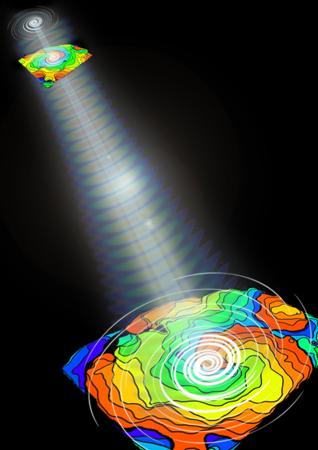Oct 20 2015
We depend on electrical waves to regulate the rhythm of our heartbeat. When those signals go awry, the result is a potentially fatal arrhythmia. Now, a team of researchers from Oxford and Stony Brook universities has found a way to precisely control these waves - using light. Their results are published in the journal Nature Photonics on 19 October.
 Using computer-generated light patterns, researchers were able to control the direction of spiralling electrical waves in heart cells. Credit: Eana Park
Using computer-generated light patterns, researchers were able to control the direction of spiralling electrical waves in heart cells. Credit: Eana Park
Both cardiac cells in the heart and neurons in the brain communicate by electrical signals, and these messages of communication travel fast from cell to cell as 'excitation waves'. Interestingly, such waves are also found in a range of other processes in nature, from chemical reactions to yeast and amoebas.
For heart patients there are currently two options to keep these waves in check: electrical devices (pacemakers or defibrillators) or drugs (eg beta blockers). However, these methods are relatively crude: they can stop or start waves but cannot provide fine control over the wave speed and direction. This is like being able to start or stop a boat but without the ability to steer it. So, the research team set out to find ways to steer the excitation waves, borrowing tools from the developing field of optogenetics, which so far has been used mainly in brain science.
Dr Gil Bub, from Oxford University explained: 'When there is scar tissue in the heart or fibrosis, this can cause part of the wave to slow down. That can cause re-entrant waves which spiral back around the tissue, causing the heart to beat much too quickly, which can be fatal. If we can control these spirals, we could prevent that.
'Optogenetics uses genetic modification to alter cells so that they can be activated by light. Until now, it has mainly been used to activate individual cells or to trigger excitation waves in tissue. We wanted to use it to very precisely control the activity of millions of cells.'
A protein called channelrhodopsin was delivered to heart cells using gene therapy techniques so that they could be controlled by light. Then, using a computer-controlled light projector, the team was able to control the speed of the cardiac waves, their direction and even the orientation of spirals in real time - something that never been shown for waves in a living system before.
In the short term, the ability to provide fine control means that researchers are able to carry out experiments at a level of detail previously only available using computer models. They can now compare those models to experiments with real cells, potentially improving our understanding of how the heart works. The research can also be applied to the physics of such waves in other processes. In the long run, it might be possible to develop precise treatments for heart conditions.
Dr Emilia Entcheva, from Stony Brook University, said: 'The level of precision is reminiscent of what one can do in a computer model, except here it was done in real heart cells, in real time.
'Precise control of the direction, speed and shape of such excitation waves would mean unprecedented direct control of organ-level function, in the heart or brain, without having to focus on manipulating each cell individually. This ideal therapy has remained in the realm of science fiction until now.'
The team stresses that there are significant hurdles before this could offer new treatments - a key issue is being able to alter the heart to be light-sensitised and being able to get the light to desired locations. However, as gene therapy moves into the clinic and with miniaturization of optical devices, use of this all-optical technology may become possible. In the meantime, the research enables scientists to look into the physics behind many biological processes, including those in our own brains and hearts.